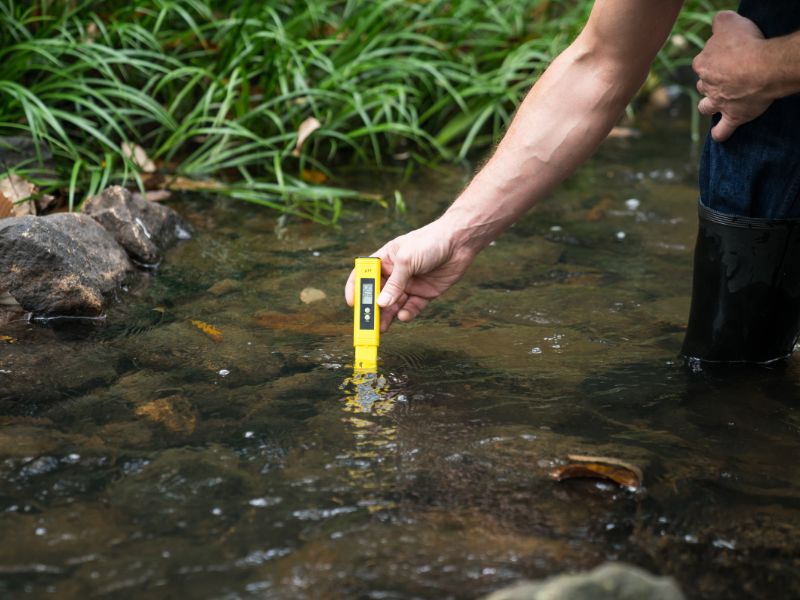In today’s context, water pollution has become a severe problem, especially in large urban areas and industrial zones. The increasing discharge of industrial and domestic wastewater has degraded water quality, affecting public health and ecosystems. In response to this situation, water quality monitoring is considered a crucial tool for protecting and preserving clean water. By tracking and assessing water quality, environmental monitoring helps detect early signs of pollution, thereby enabling timely and effective treatment measures, ensuring safety for both humans and the environment.

What is Water Quality Monitoring?
Water quality monitoring is the process of measuring physical, chemical, and biological parameters of water environments. This process is carried out according to a detailed plan regarding time, space, methods, and measurement procedures. Data collected from this process provides reliable and accurate basic information, helping managers assess changes in water quality.
Why is Water Quality Monitoring Important?
Water quality monitoring plays a crucial role in:
-
- Assessing surface water quality: Determining the status and assessing the level of surface water pollution in various regions and localities.
- Ensuring compliance with standards: Determining the conformity of water environments with permissible standards.
- Monitoring changes in water quality: Providing data over time and space, helping to detect early negative changes.
- Early warning of pollution risks: Issuing early warnings about pollution risks, thereby enabling timely preventive measures.
- Supporting environmental management: Providing necessary data for national, regional, and local environmental management.

Selection of Water Monitoring Locations
When conducting water environment monitoring for water bodies such as rivers and streams, selecting sampling locations is crucial:
Monitoring Baseline Quality
-
- Upstream: Choose locations upstream, where the water has not been impacted by discharge sources, to sample natural water representative of baseline quality.
- Hydrological Representation: Distribute monitoring points evenly across different water bodies, representing distinct hydrological characteristics.
- Confluence Branches: If monitoring at river confluences, select sampling points after the branches merge to assess the combined water quality.
Monitoring Impacts
-
- Discharge Sources: For impact monitoring, choose locations near discharge sources, downstream of the discharge, and where the water is well-mixed.
- Tributaries Entering the Main Stream: When a tributary enters the main stream, select at least two monitoring points: one upstream before the tributary enters and one downstream after complete mixing. This distance should be sufficient (about 1 km) to ensure complete vertical mixing. Horizontal monitoring should also be considered, especially when there are bends in the flow, typically spaced several kilometers apart.
- Tidal-Influenced Rivers: For rivers affected by tides, it is important to understand the tidal regime to sample at the right time, preferably during low tide, to ensure data representativeness and accuracy.

Water Environment Monitoring Parameters
Monitoring parameters include:
-
- On-site Measurement Parameters: pH, temperature, dissolved oxygen (DO), electrical conductivity (EC), turbidity, total dissolved solids (TDS).
- Other Parameters: Color, total suspended solids (TSS), biochemical oxygen demand (BOD5), chemical oxygen demand (COD), nitrite (NO2–), ammonium (NH4+), sulfate (SO42-), phosphate (PO43-), total nitrogen (T-N), silicate (SiO32-), total iron, chloride (Cl–), fluoride (F–), alkalinity, coliform, E. coli, fecal coliform, cyanide (CN–), oil, grease, arsenic, cadmium, chromium, lead, mercury, zinc, copper, nickel, manganese, sodium, potassium, magnesium, calcium ions, phenol, and other surface-active substances.

Sampling Frequency and Timing in Water Environment Monitoring
The frequency and timing of sampling in water environment monitoring depend on the requirements of environmental management and the specific characteristics of the water source.
- Baseline Monitoring: Conducted at least once a month to monitor baseline water quality, ensuring regular and accurate data collection.
- Impact Monitoring: Performed at least once per quarter to monitor and assess the impact of discharge activities on the water environment.
In cases of periodic or frequent changes, monitoring should be designed with short intervals between consecutive sampling events to promptly detect fluctuations in water quality. The general principle is that the more frequent the sampling, the more accurate the results, minimizing discrepancies and ensuring high reliability in assessment.
